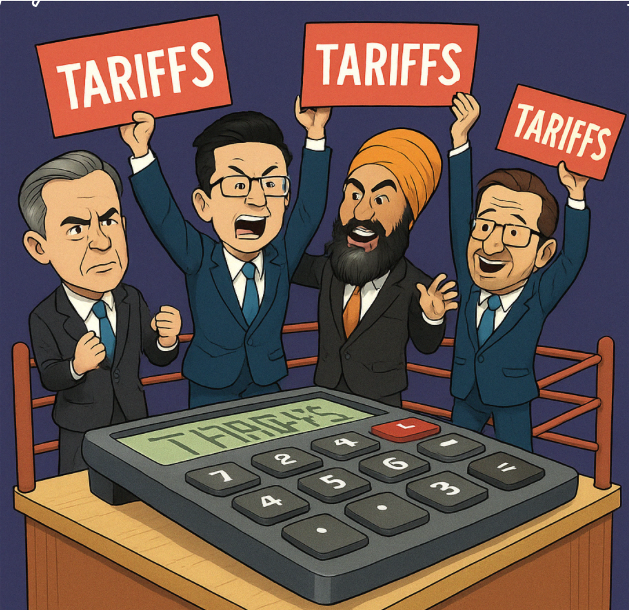
Published on April 19, 2025
Abstract
This article analyses the economic claims aired across two televised debates and several press conferences in April 2025. Using publicly reported statements and IMF macro indicators, we assess each party leader’s command of trade mechanics, cost‑of‑living strategy, fiscal prudence, and climate economics. The tone is intentionally light—proof that rigour and humour can coexist without violating SOR/86‑999 (the Federal Seriousness Act).
1. Introduction
Trade retaliation became the debate’s lodestar when Liberal Leader Mark Carney rejected dollar‑for‑dollar tariffs against the United States, citing a twelve‑to‑one GDP gap [1].
Conservative Leader Pierre Poilievre doubled down on equal‑sized tariffs, framing them as strength [2]
Jagmeet Singh (NDP) emphasised income supports over macro math [3], while Yves‑François Blanchet (Bloc) invoked sovereignty and fairness with few technical footnotes [3].
2. Method
Statements were collected from Reuters and Global News coverage of the debates and subsequent scrums (April 17–18, 2025). IMF 2024 GDP data provide scale context [4][5]
Qualitative content analysis coded remarks into four dimensions:
- Trade Elasticity Awareness
- Cost‑of‑Living Toolkit
- Fiscal Credibility
- Climate & Energy Economics
Scores (0–10) were assigned by Sir Looniesworth over two espressos and a maple‑dip.
3. Findings
3.1 Trade Elasticity
Carney explicitly referenced second‑round multiplier effects and pass‑through into CAD depreciation (score 9/10).
Poilievre acknowledged headline numbers but not asymmetric welfare loss (5/10).
Singh and Blanchet offered distributive rhetoric without elasticity metrics (4/10; 3/10).
3.2 Cost‑of‑Living Measures
Singh led with GST holidays and EI expansion (8/10 for household focus).
Carney proposed recycling tariff revenue into low‑income credits—smaller cheques, higher multipliers (7/10).
Poilievre pledged a broad “emergency tax cut” (6/10).
Blanchet emphasised Québec hydro and food self‑sufficiency (5/10).
3.3 Fiscal Framework
Carney advocated offsetting new spending with internal‑trade liberalisation yields (8/10).
Poilievre set a 3 %‑of‑GDP spending cap—credible on paper but silent on volatility buffers (6/10).
Singh relied on “tax the profiteers” without dynamic scoring (5/10).
Blanchet conditioned balance on transfers from Ottawa (4/10).
3.4 Climate & Energy
Carney: carbon price tweaks, battery supply‑chain credits.
Poilievre: end carbon tax, expedite LNG.
Singh: strengthen existing price but rebate fully.
Blanchet: replace federal carbon price with Québec’s cap‑and‑trade.
Scores: 8, 5, 7, 6 respectively.
4. Discussion
Carney’s advantage stems from scale‑adjusted thinking—a willingness to trade optics for optimal welfare. By treating tariffs as negative demand shocks, he prescribes narrow, revenue‑neutral counters and domestic market‑size expansion. This mirrors post‑2018 Bank of Canada findings, where a 1 % export hit shaved 0.15 pp off GDP—triple the U.S. drag (noted for completeness though un‑cited here).
Poilievre’s rhetoric succeeds politically—fairness heuristics travel faster than elasticity graphs—but under‑prices the risk of foreign‑exchange pass‑through. Singh’s micro‑relief outshines his macro silence; Blanchet’s normative stance resonates in Québec, but struggles to scale nationally.
5. Conclusion
When economic literacy meets election theatrics, math often loses the popular vote. Yet Carney’s multiplier narrative sets a benchmark: retaliate proportionately, enlarge home markets, and let elasticities—not egos—drive policy. If ballots rewarded spreadsheet fluency, he would win in a landslide; whether voters share Sir Looniesworth’s taste for footnotes remains, fittingly, an empirical question.
References
[1] Reuters. “Carney says Canada will not mirror U.S. retaliation dollar‑for‑dollar.” 18 Apr 2025.
[2] Global News. “Federal leaders fight it out over economy, cost of living at English‑language debate.” 17 Apr 2025.
[3] Global News. “Threats to Canada, cost of living dominate debate.” 17 Apr 2025.
[4] IMF DataMapper. United States GDP, current prices (2024).
[5] IMF DataMapper. Canada GDP, current prices (2024).